Syria - Dead Cities
The Dead Cities date from the time when the northern part of Syria (between Aleppo-Hama in the east, and the Orontes river in the west) was part of the hinterland of the Byzantine Christian city of Antioch. There are thought to be nearly 800 sites, some of them being single monuments, others being whole villages containing houses, churches, wine presses, baths, etc. Among the sites are over 2,000 churches, spread over a hilly area measuring about 140km by 30km. UNESCO is currently in the process of declaring the whole area a World Heritage Site, which would make it the sixth in Syria.
Nobody is quite sure why these sites were all abandoned, but the current theory is that it was due to demographic shifts, trade routes changed and the people moved (other theories include Muslim invasions, Christian persecution, nomad incursions). Some of the Dead Cities are lived in to this day, local villagers use the temples and churches to keep their goats and sheep, and build mud-brick houses against old walls and caves. Wood was scarce in the region, so most of the permanent buildings were built from stone (no cement was used), which is why most of the cities are in such a good condition.
The general layout of a settlement was usually surrounded by an enclosure wall containing watch towers. There were paved streets running between market places, monasteries, churches, inns, private homes and public meeting places. Market stalls lined the streets, most private houses had 2 stories and were decorated with colonnades and logias. The necropolis was usually on the outskirts of the settlement and contained various types of tombs, some designed like temples, some carved out of rock, others contained massive sarcophagi placed on bare earth. Many of the buildings contain inscriptions which give the name of the owner or deceased, date of construction or even personal wishes and invocations.
The cities were first "discovered" by westerner Marquis de Vogue who visited the area in 1860. American expeditions in 1899,1901, 1904, and 1905 followed, after which 20th century archeologists started doing more extensive studies of the region.
The vast majority of the sites are not in any guidebooks, and many have no names. Some of them are inhabited by wild dogs which have been known to attack visitors (I had this problem in Ruweiha, and ended up carrying around a big stick with me as a deterrent).
One of the last stretches of Roman roads remaining in Syria. The rocks in the second picture have been worn out by the hooves of horses and donkeys loaded with cargo.
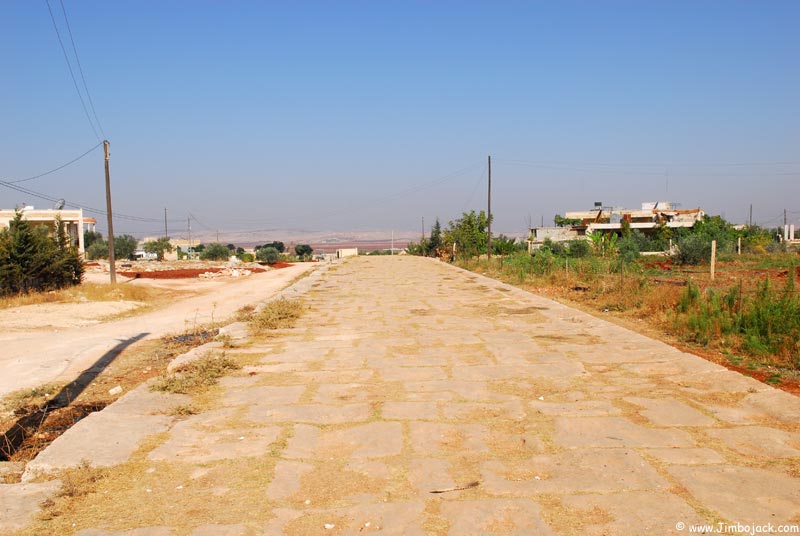
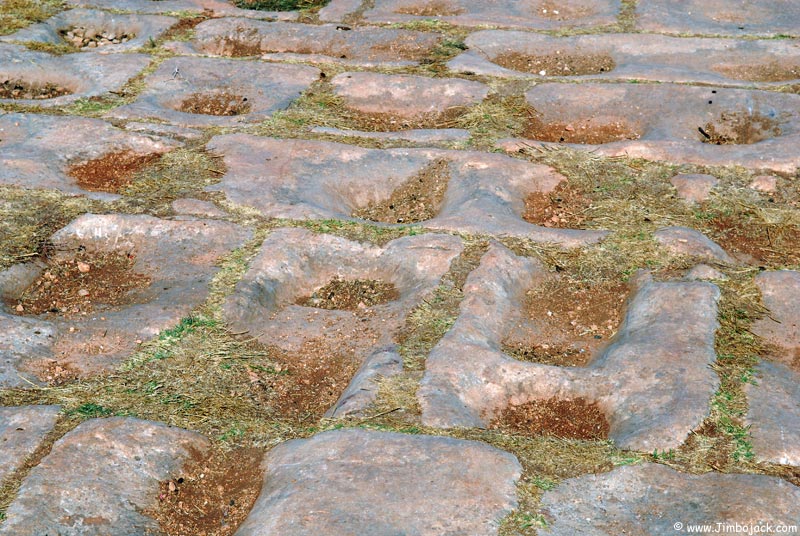
Remains of a Byzantine fortress
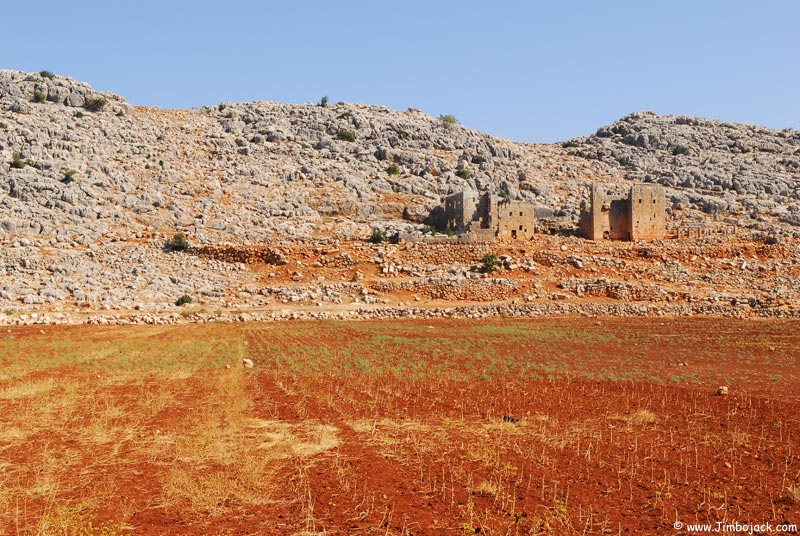
Syria/Turkey border. The completely dry area of the field is Syria, the cultivated fields are on the Turkish side
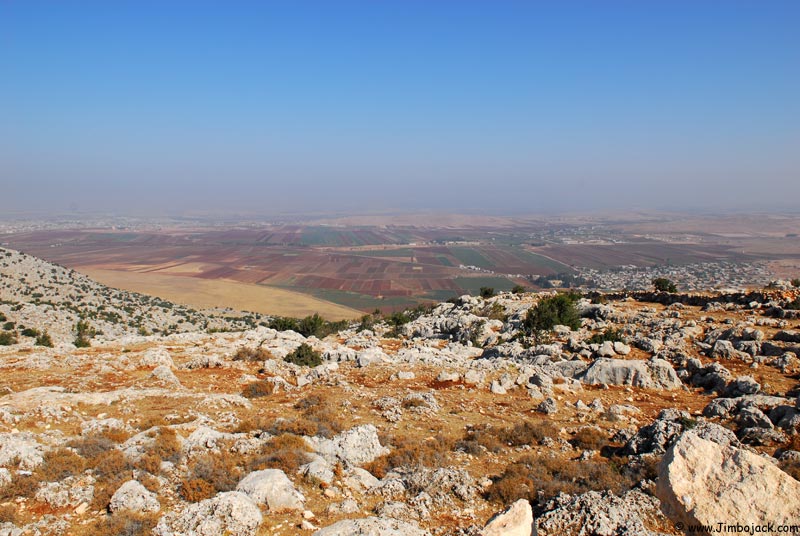
Qalb Lozeh
This is one of the best preserved Syrian-Byzantine ecclesiastical buildings. The church is thought to have been built during the lifetime of St. Simeon (who died in 459) or right after his death. It was designed as a stop-off point for pilgrims (the worlds first tourists!) on their way to the famous St. Simon monastery and to see Simon on top of his pillar. The facts that no other buildings survived in the area intact, that it was far too big for the local village population, and that a walled compound surrounded the church confirm that it was designed as a pilgrimage site. The church is almost completely intact and the structure, columns and classical decoration are a precursor to the Romanesque style which became very popular in Europe. Many of its features were copied, enhanced and refined in the great basilica of St. Simeon which was built several decades later. It was rediscovered in 1862 by Frenchman Marquis de Vogue, and studied in detail in 1935 by the French Dead City specialist Georges Tchalenko.
Today the church is located right next to a Druze village of Qalb Lozeh (meaning "heart of the almond" in Arabic) and is just a couple of kilometers from the Turkish border. Unfortunately, parts of the north wall have been taken by local villages and used in various building projects over the years.
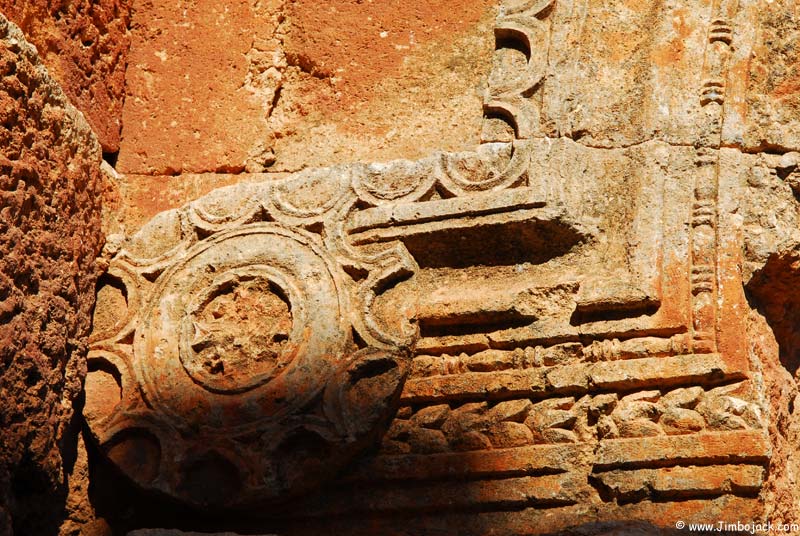


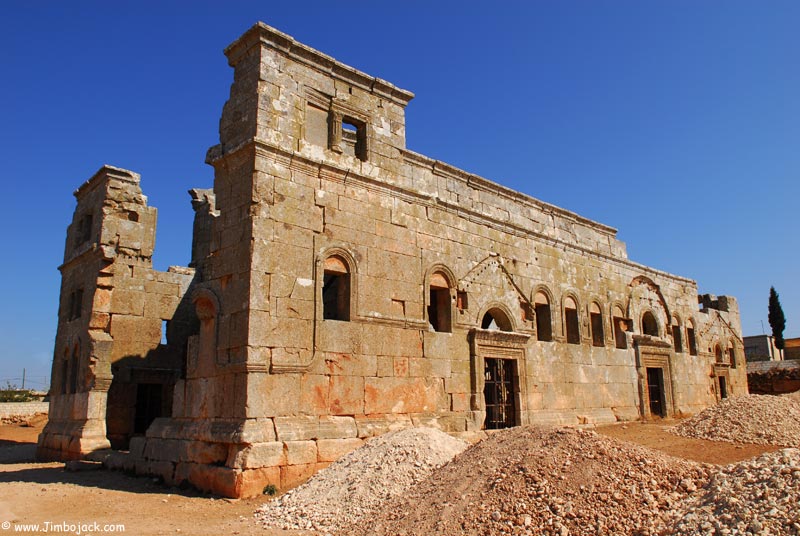

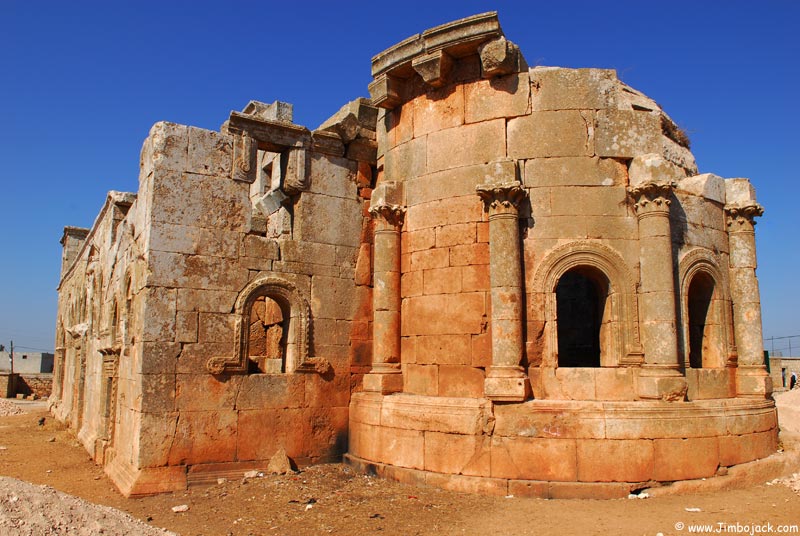
A dead city about 2 kilometers away from Qalb Lozeh
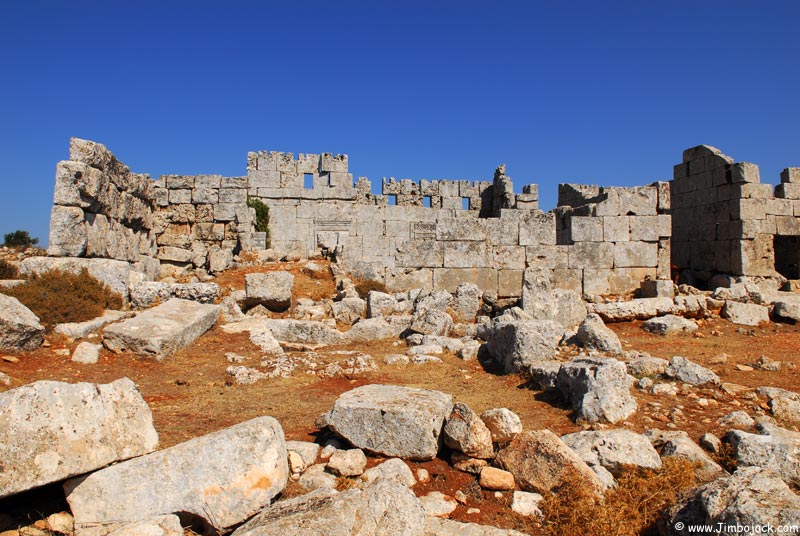
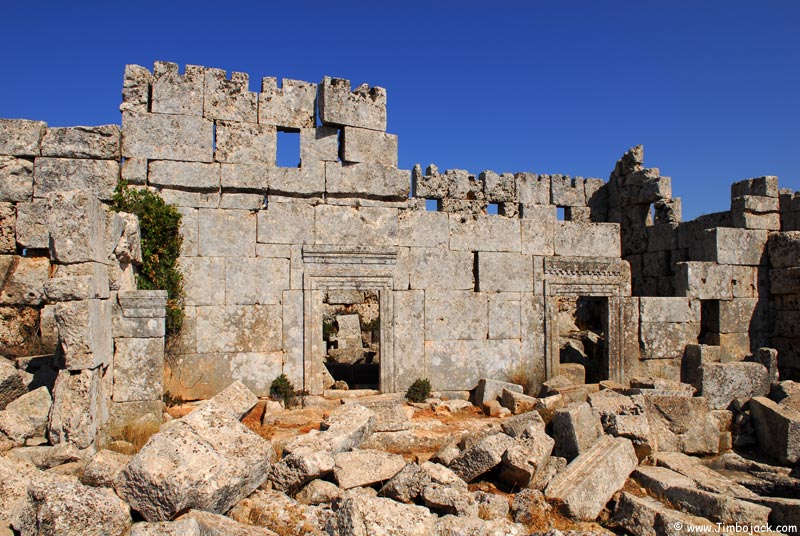
The dead cities of Bakira and Darkita

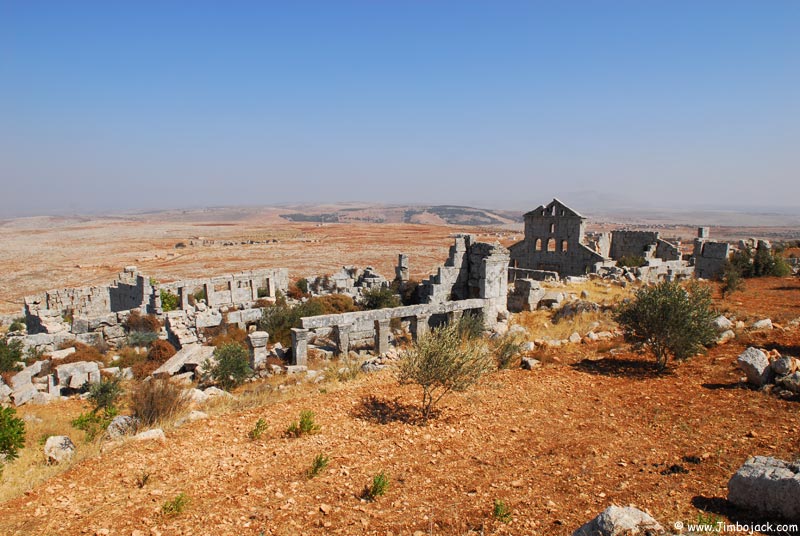
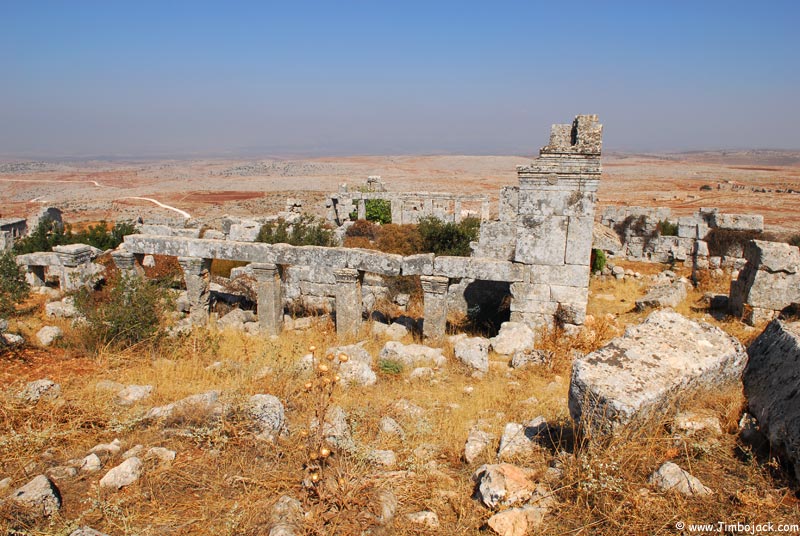
Qatura
Roman tombs were cut into the rock here along with Greek and Latin inscriptions. The carvings above the tombs represent the people that were buried in them. The eagle represents a Roman military general who was buried here along with 2 other soldiers.
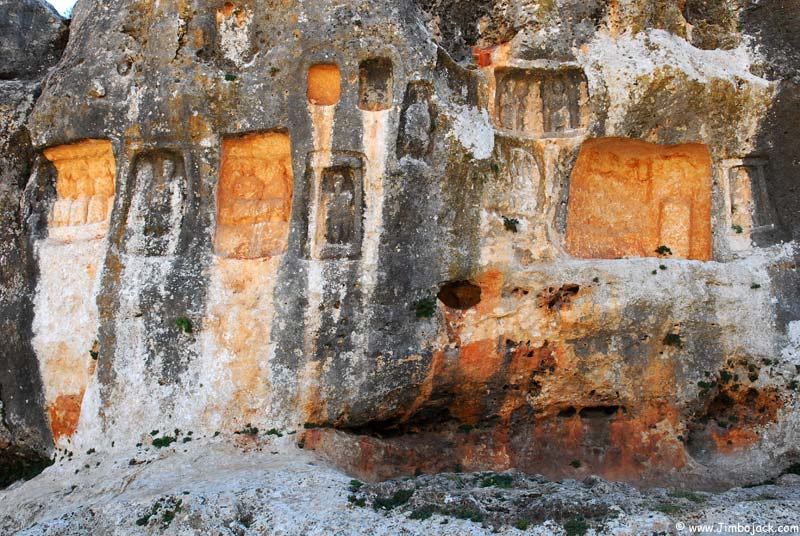
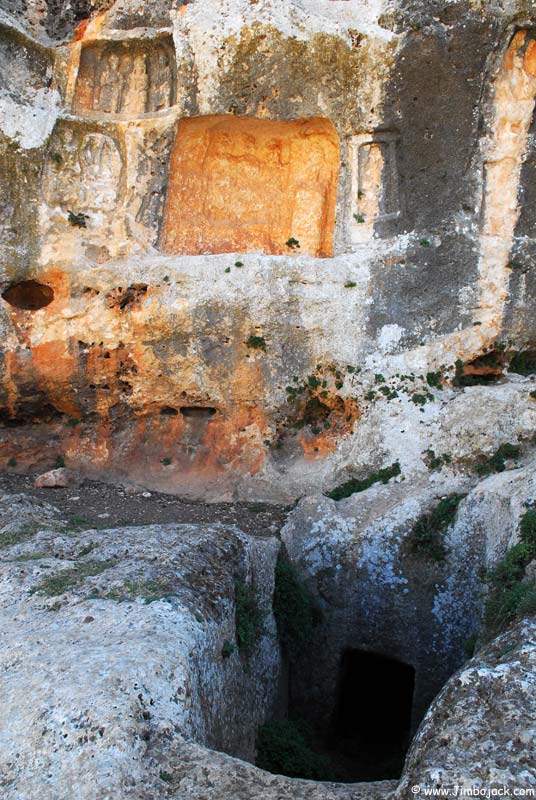
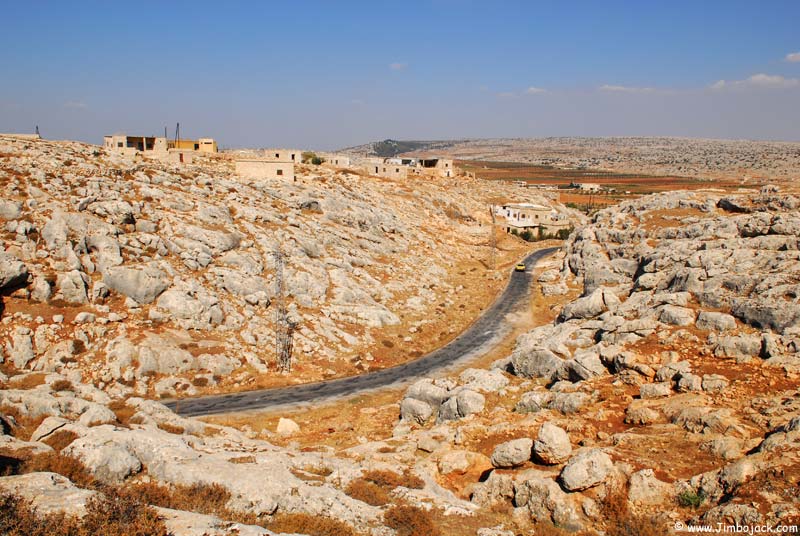
Houses constructed on top of some of the tombs, the tombs themselves are used to provide shelter for sheep and goats.

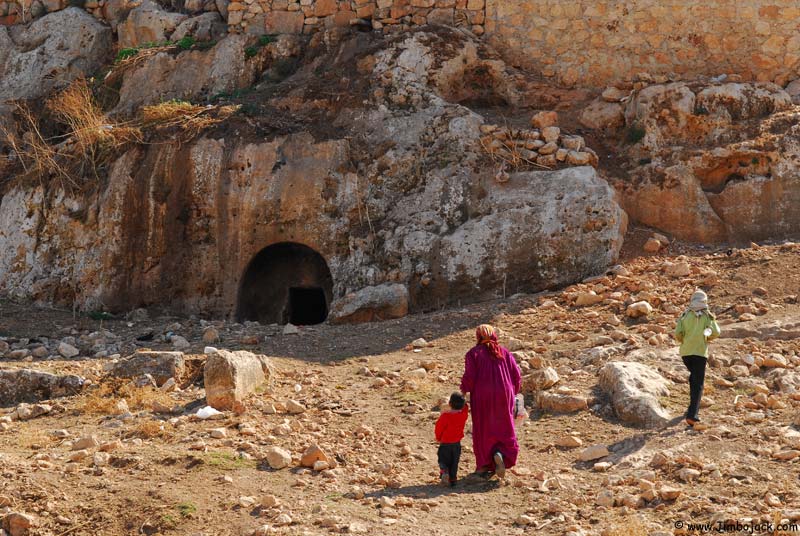
Qala'at Samaan (St. Simeon)
The ruined basilica of St. Simeon has been a pilgrimage destination and a tourist site since the 5th century. Simeon, a son of a Sheppard, was born in 392 and joined the monastery in Telanissos at the age of 20 after having a revelation. He soon left the monastery after finding the life too undemanding, and began living in a cave nearby under a strict self imposed regime. His fame and reputation grew as stories of his deeds spread. He would bury himself up to the chin during the summertime, chain himself to a rock at a nearby hilltop and wear spikes which drew blood.
After people found out about this extremely pious individual, they started arriving in order to meet him and receive his blessing. Simeon greatly resented this invasion of his privacy, and erected a 3 meter high pillar on which he resided so that no people would be able to touch or poke him. As time went on, the pillar grew to 6, 11 and finally ended up measuring 18 meters. Simeon spent a total of 36 years on the pillar, during which time a railing was constructed at the top, and Simeon was chained to it from a collar around his neck so that he would not fall off during the middle of the night. Once a week his disciples brought him food on a ladder, although nobody knows what his hygiene arrangements were.
His prayers consisted of stretching out his arms, bending his hips and making his head touch his toes, and straightening himself up again. He would do this over 100 times daily as pilgrims below kept count. This way of praying helped him stay flexible and provided him with much needed exercise.
His increasingly eccentric behavior started attracting more and more pilgrims from as far away as England and France, where he became known as Simon Stylites (The name was derived from the Greek work for pillar, "stylos"). Eventually stylism caught on, and copycat pious pillar-top dwelling people started popping up in lands as far away as Central Europe. It eventually faded there, probably in the face of a very cold climate. The last recorded stylite was at Mt. Athos in the 16th century, 1100 years after Simon’s death. Simeon’s feast is the 1st of September in the Eastern Orthodox Church, 27th of July in the Syrian Orthodox Church, and the 5th of January in the West.
St. Simeon preached twice daily from his perch and answered peoples questions. He did however refuse to see or talk to women, even his mother was not allowed anywhere near his column. According to the first-hand account of his life written by Theodoret, Bishop of Cyrrhus, even the Byzantine emperor consulted him on matters of doctrine. After his death in 459, Simon became the most famous person in the 5th century world. His body was taken by 600 troops sent by the emperor to be buried in the great Christian center of Antioch (now known as Antakya), later moved to Constantinople, and an enormous church was built around his famous pillar.
The unique design of the church was made up of four basilicas arranged in the shape of a cross, each opening into a central yard that was covered by a dome. The wooden central dome covered Simon’s pillar but collapsed in the 528 earthquake and was never rebuilt again. The largest of the basilicas was used for worship, while the other three provided housing for the many pilgrims that came to visit the site. After 14 years of building, it was completed in 490 becoming the largest and most important church in the world at the time. It was only surpassed by the building of Haghia Sophia in Constantinople, and was not rivaled in Europe until the 11th and 12th centuries.
The construction of the complex was a huge undertaking; it involved skilled artisans and architects from both of the two Byzantine centers of Antioch and Constantinople. The top of the hill had to be flattened in order to create an esplanade large enough for all of the planned construction.
The reasons for the construction were largely political; at the time the Eastern Church was in turmoil over the nature of Christ. Emperor Zenon hoped that by building the church he would be able to reinforce Byzantine orthodoxy and power in the region, in opposition to the Monophysites in Antioch.
In 526 and 528 earthquakes hit the area, but did not do much damage to the complex. Muslims arrived to the area during the 7th century, but allowed Christian worship to continue. In the 10th century Christian and Muslim relations deteriorated and the Byzantine Christians fortified the church complex (Hence the current Arabic name Qala'at Sam’aan, meaning "fortress of Simeon"). It was captured in 985 by Saif Ad-Dawla of Aleppo, and later sacked in 1017 by the Islamic Fatimid dynasty armies from Egypt. It was still used as a pilgrimage center until the 12th century, at which time it was abandoned and left mostly as it is today.
The church is very well preserved today, the main Romanesque facade stands and there are many carved ornamental stone works to admire. The octagonal yard and arches behind the facade are fairly complete, but Simon's pillar has been reduced to nothing more then a boulder by centuries of pilgrims chipping away at it for holly souvenirs.
At the foot of the hill where the basilica is located is the town of Deir Samaan. It began as Telanissos, a small Greek agricultural village. As Simon’s fame grew, it began being rapidly transformed by large number of pilgrims eager to get a glimpse of the famous pillar dweller. Hotels, churches and three monasteries were built to accommodate all of the arriving pilgrims. Eventually, with the building of the basilica after Simon's death, the two were connected by a procession way (Via Sacra). Local people today live near and in some of the ruins, 200+ meters away downhill from the basilica.
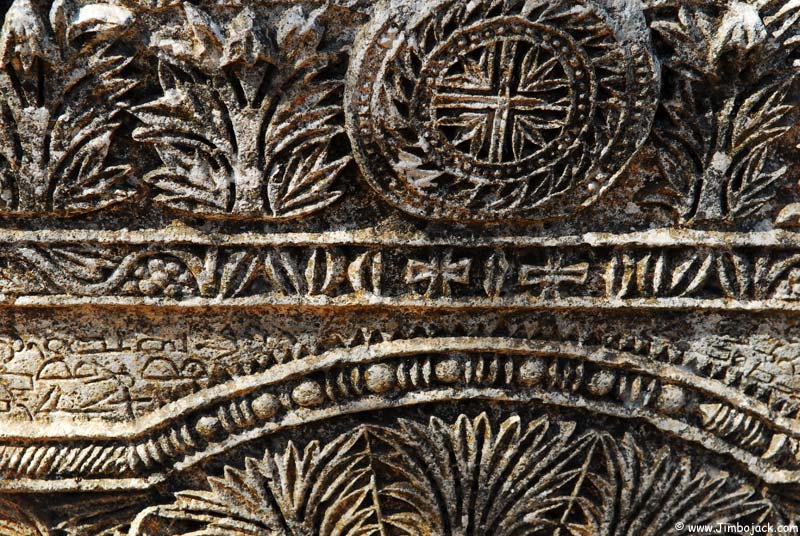
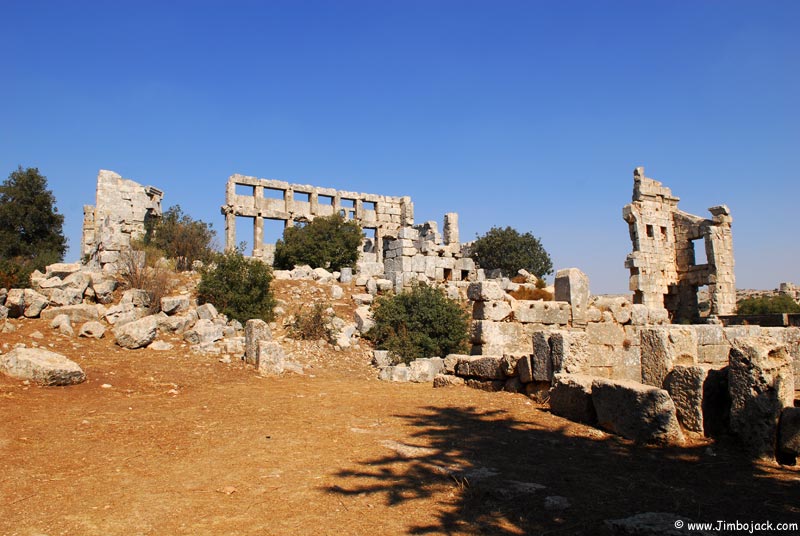
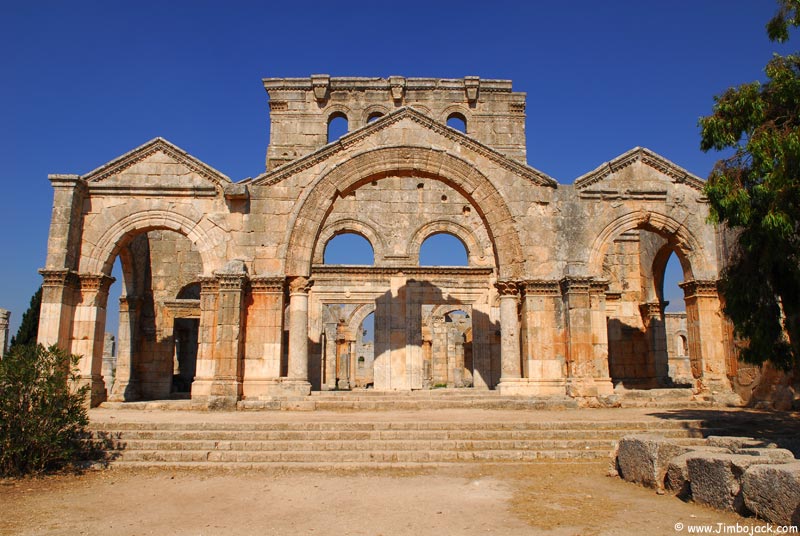
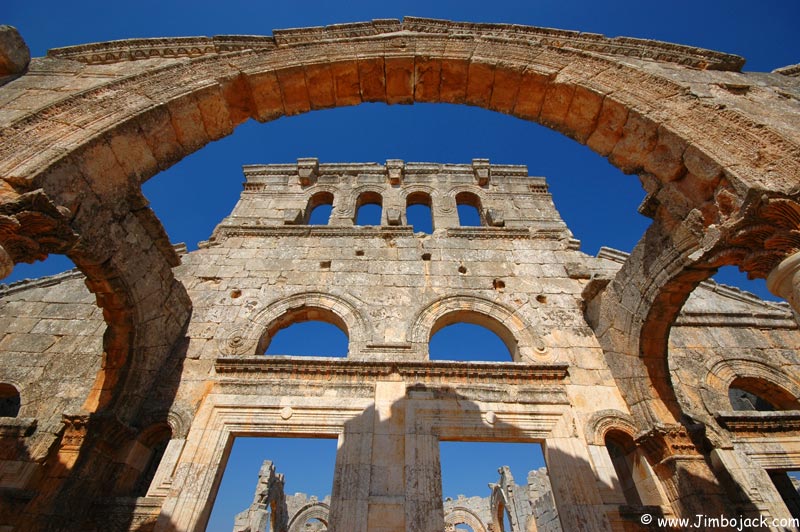
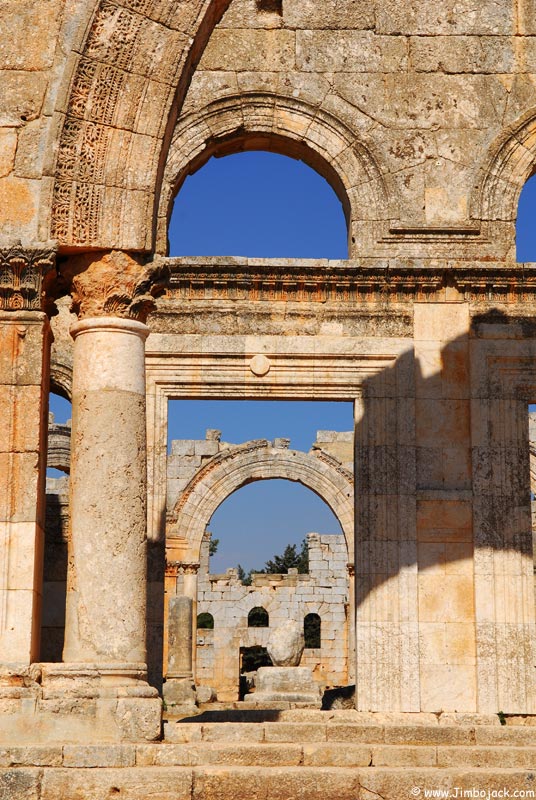
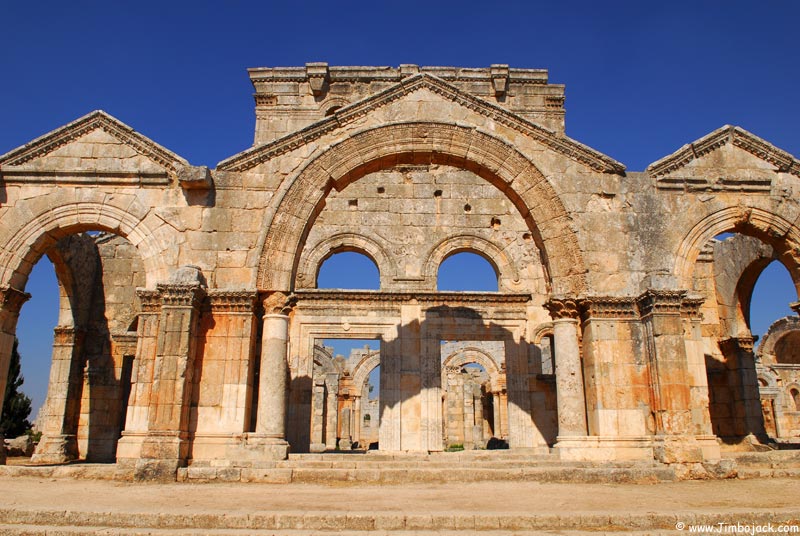
The boulder in the middle of the following pictures is all that remains of the pillar

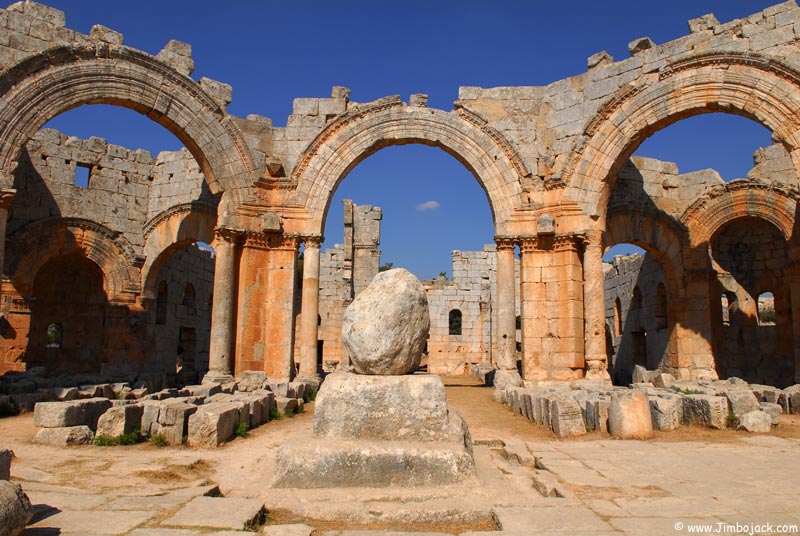

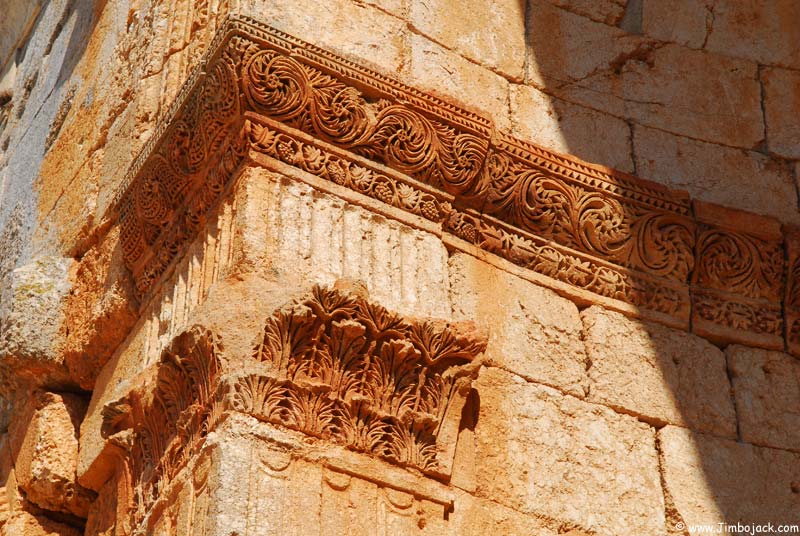
View from the top
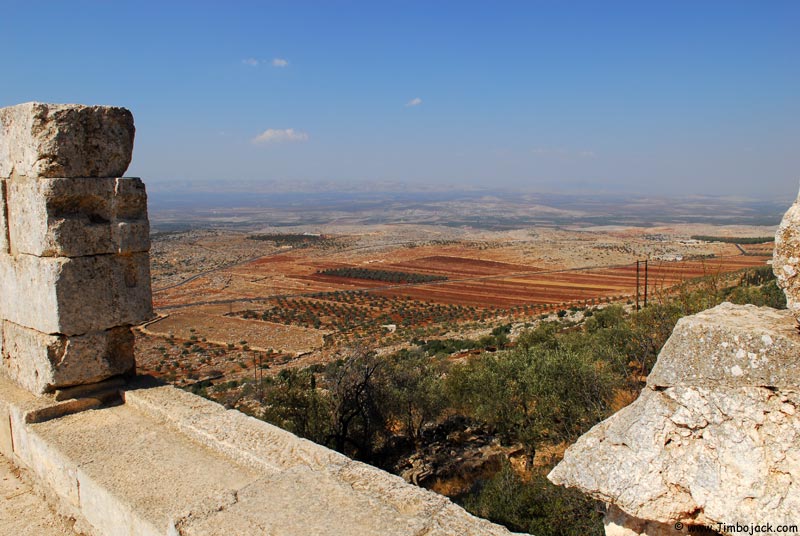
Many landowners hire local families to live in tents in their fields, the families keep watch over whatever is growing and help pick the fruits/nuts/vegetables. They usually live there for a few months, and move after the harvest is complete. This part of Syria is famous for pomegranates, almonds and pistachios.
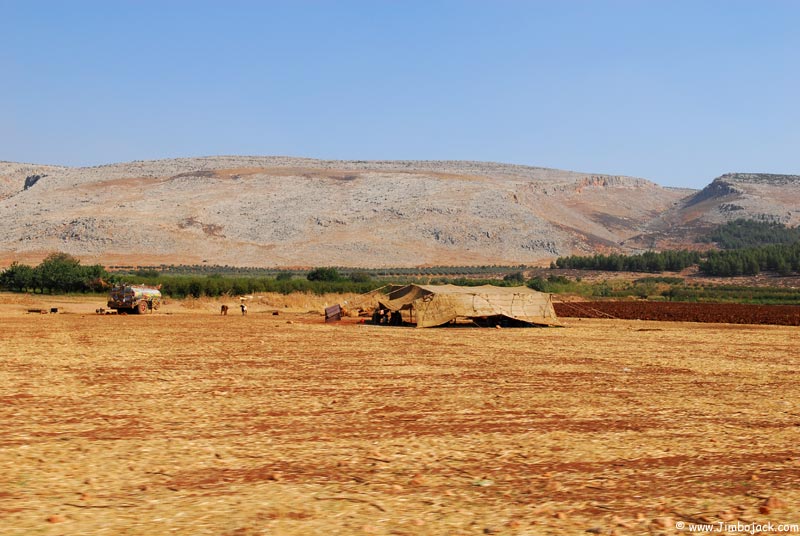
Ain Dara
Neo-Hittite temple ruins of Ain Dara, dated to the 10th-9th century B.C. The site was being constructed when the area was invaded by the Assyrian armies of Salmanazar III. The temple was dedicated to the goddess Ishtar, a Semitic goddess of fertility (represented by a lion). The Assyrian/Babylonian goddess Ishtar was equated with the Phoenician goddess of love and fertility Astarte, who was identified with the Egyptian Isis, then later with the Greek Aphrodite and the Roman goddess Venus. It is the only site in Syria containing ruins dating from this period
The entrance to the temple is flanked on both sides by winged lions and sphinxes, representing the Hittite gods of the sun, moon, water and fertility.
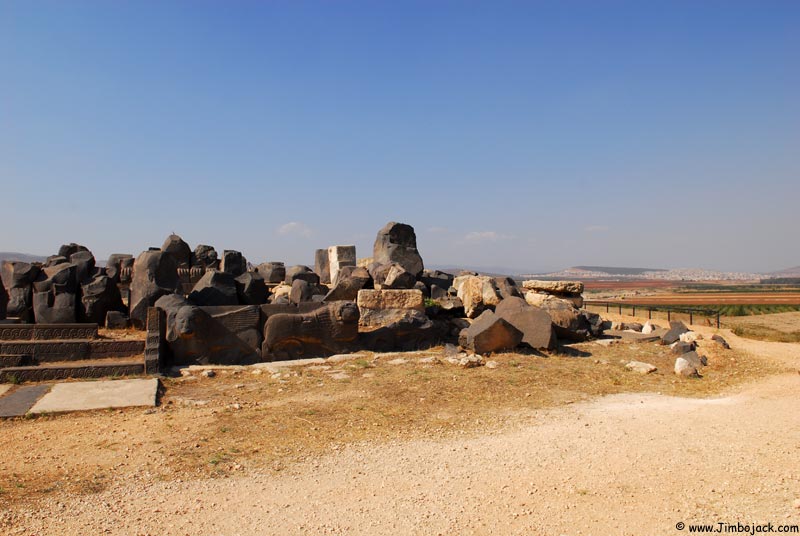

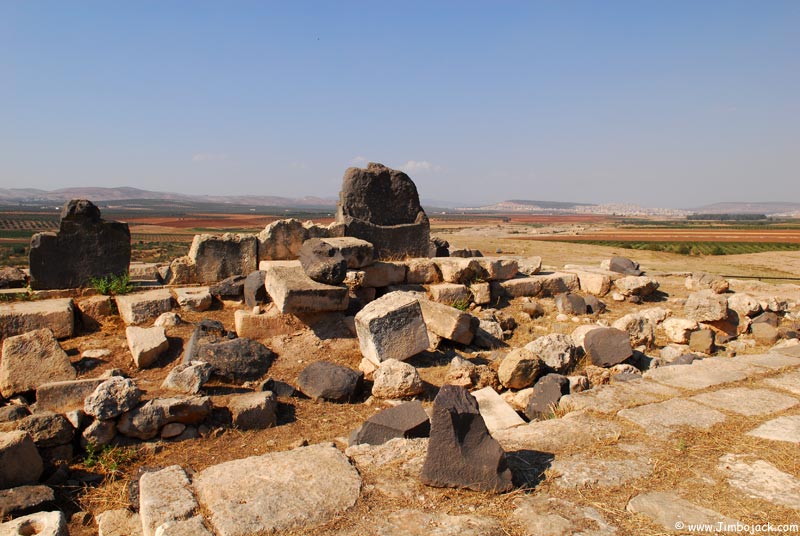
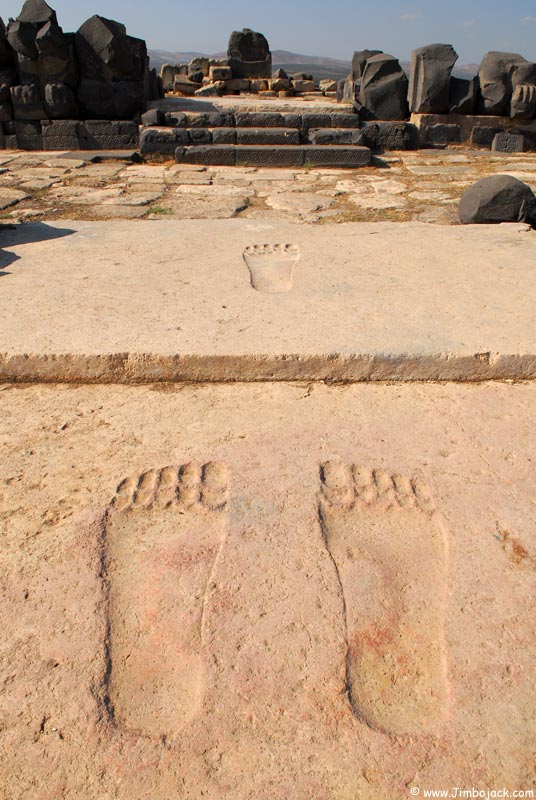
A boy on a donkey and his goats
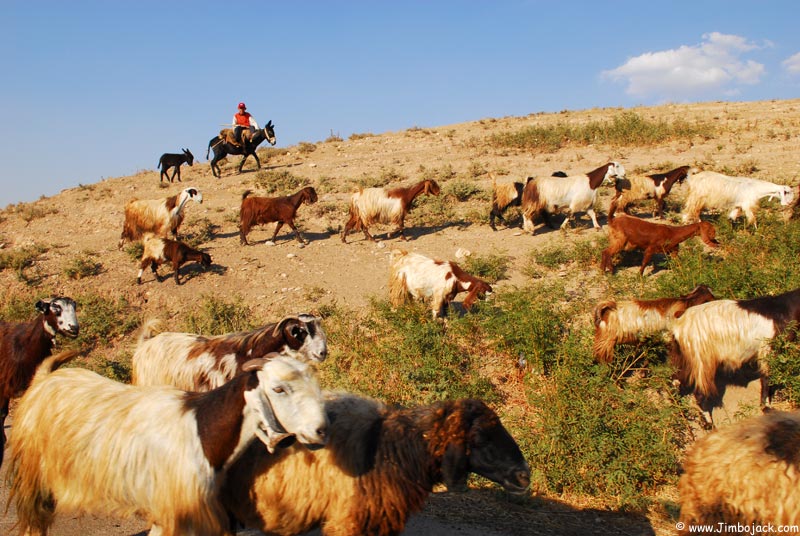
I was able to visit these sites by hiring a taxi driver in Aleppo that worked as an unofficial tour guide, he knew many sites that were not in any guidebooks and took me to them.
I hope you enjoy this series, more photos from these sites are on my website:
http://jimbojack.com/Countries/Syria.htm
Nobody is quite sure why these sites were all abandoned, but the current theory is that it was due to demographic shifts, trade routes changed and the people moved (other theories include Muslim invasions, Christian persecution, nomad incursions). Some of the Dead Cities are lived in to this day, local villagers use the temples and churches to keep their goats and sheep, and build mud-brick houses against old walls and caves. Wood was scarce in the region, so most of the permanent buildings were built from stone (no cement was used), which is why most of the cities are in such a good condition.
The general layout of a settlement was usually surrounded by an enclosure wall containing watch towers. There were paved streets running between market places, monasteries, churches, inns, private homes and public meeting places. Market stalls lined the streets, most private houses had 2 stories and were decorated with colonnades and logias. The necropolis was usually on the outskirts of the settlement and contained various types of tombs, some designed like temples, some carved out of rock, others contained massive sarcophagi placed on bare earth. Many of the buildings contain inscriptions which give the name of the owner or deceased, date of construction or even personal wishes and invocations.
The cities were first "discovered" by westerner Marquis de Vogue who visited the area in 1860. American expeditions in 1899,1901, 1904, and 1905 followed, after which 20th century archeologists started doing more extensive studies of the region.
The vast majority of the sites are not in any guidebooks, and many have no names. Some of them are inhabited by wild dogs which have been known to attack visitors (I had this problem in Ruweiha, and ended up carrying around a big stick with me as a deterrent).
One of the last stretches of Roman roads remaining in Syria. The rocks in the second picture have been worn out by the hooves of horses and donkeys loaded with cargo.


Remains of a Byzantine fortress

Syria/Turkey border. The completely dry area of the field is Syria, the cultivated fields are on the Turkish side

Qalb Lozeh
This is one of the best preserved Syrian-Byzantine ecclesiastical buildings. The church is thought to have been built during the lifetime of St. Simeon (who died in 459) or right after his death. It was designed as a stop-off point for pilgrims (the worlds first tourists!) on their way to the famous St. Simon monastery and to see Simon on top of his pillar. The facts that no other buildings survived in the area intact, that it was far too big for the local village population, and that a walled compound surrounded the church confirm that it was designed as a pilgrimage site. The church is almost completely intact and the structure, columns and classical decoration are a precursor to the Romanesque style which became very popular in Europe. Many of its features were copied, enhanced and refined in the great basilica of St. Simeon which was built several decades later. It was rediscovered in 1862 by Frenchman Marquis de Vogue, and studied in detail in 1935 by the French Dead City specialist Georges Tchalenko.
Today the church is located right next to a Druze village of Qalb Lozeh (meaning "heart of the almond" in Arabic) and is just a couple of kilometers from the Turkish border. Unfortunately, parts of the north wall have been taken by local villages and used in various building projects over the years.






A dead city about 2 kilometers away from Qalb Lozeh


The dead cities of Bakira and Darkita



Qatura
Roman tombs were cut into the rock here along with Greek and Latin inscriptions. The carvings above the tombs represent the people that were buried in them. The eagle represents a Roman military general who was buried here along with 2 other soldiers.



Houses constructed on top of some of the tombs, the tombs themselves are used to provide shelter for sheep and goats.


Qala'at Samaan (St. Simeon)
The ruined basilica of St. Simeon has been a pilgrimage destination and a tourist site since the 5th century. Simeon, a son of a Sheppard, was born in 392 and joined the monastery in Telanissos at the age of 20 after having a revelation. He soon left the monastery after finding the life too undemanding, and began living in a cave nearby under a strict self imposed regime. His fame and reputation grew as stories of his deeds spread. He would bury himself up to the chin during the summertime, chain himself to a rock at a nearby hilltop and wear spikes which drew blood.
After people found out about this extremely pious individual, they started arriving in order to meet him and receive his blessing. Simeon greatly resented this invasion of his privacy, and erected a 3 meter high pillar on which he resided so that no people would be able to touch or poke him. As time went on, the pillar grew to 6, 11 and finally ended up measuring 18 meters. Simeon spent a total of 36 years on the pillar, during which time a railing was constructed at the top, and Simeon was chained to it from a collar around his neck so that he would not fall off during the middle of the night. Once a week his disciples brought him food on a ladder, although nobody knows what his hygiene arrangements were.
His prayers consisted of stretching out his arms, bending his hips and making his head touch his toes, and straightening himself up again. He would do this over 100 times daily as pilgrims below kept count. This way of praying helped him stay flexible and provided him with much needed exercise.
His increasingly eccentric behavior started attracting more and more pilgrims from as far away as England and France, where he became known as Simon Stylites (The name was derived from the Greek work for pillar, "stylos"). Eventually stylism caught on, and copycat pious pillar-top dwelling people started popping up in lands as far away as Central Europe. It eventually faded there, probably in the face of a very cold climate. The last recorded stylite was at Mt. Athos in the 16th century, 1100 years after Simon’s death. Simeon’s feast is the 1st of September in the Eastern Orthodox Church, 27th of July in the Syrian Orthodox Church, and the 5th of January in the West.
St. Simeon preached twice daily from his perch and answered peoples questions. He did however refuse to see or talk to women, even his mother was not allowed anywhere near his column. According to the first-hand account of his life written by Theodoret, Bishop of Cyrrhus, even the Byzantine emperor consulted him on matters of doctrine. After his death in 459, Simon became the most famous person in the 5th century world. His body was taken by 600 troops sent by the emperor to be buried in the great Christian center of Antioch (now known as Antakya), later moved to Constantinople, and an enormous church was built around his famous pillar.
The unique design of the church was made up of four basilicas arranged in the shape of a cross, each opening into a central yard that was covered by a dome. The wooden central dome covered Simon’s pillar but collapsed in the 528 earthquake and was never rebuilt again. The largest of the basilicas was used for worship, while the other three provided housing for the many pilgrims that came to visit the site. After 14 years of building, it was completed in 490 becoming the largest and most important church in the world at the time. It was only surpassed by the building of Haghia Sophia in Constantinople, and was not rivaled in Europe until the 11th and 12th centuries.
The construction of the complex was a huge undertaking; it involved skilled artisans and architects from both of the two Byzantine centers of Antioch and Constantinople. The top of the hill had to be flattened in order to create an esplanade large enough for all of the planned construction.
The reasons for the construction were largely political; at the time the Eastern Church was in turmoil over the nature of Christ. Emperor Zenon hoped that by building the church he would be able to reinforce Byzantine orthodoxy and power in the region, in opposition to the Monophysites in Antioch.
In 526 and 528 earthquakes hit the area, but did not do much damage to the complex. Muslims arrived to the area during the 7th century, but allowed Christian worship to continue. In the 10th century Christian and Muslim relations deteriorated and the Byzantine Christians fortified the church complex (Hence the current Arabic name Qala'at Sam’aan, meaning "fortress of Simeon"). It was captured in 985 by Saif Ad-Dawla of Aleppo, and later sacked in 1017 by the Islamic Fatimid dynasty armies from Egypt. It was still used as a pilgrimage center until the 12th century, at which time it was abandoned and left mostly as it is today.
The church is very well preserved today, the main Romanesque facade stands and there are many carved ornamental stone works to admire. The octagonal yard and arches behind the facade are fairly complete, but Simon's pillar has been reduced to nothing more then a boulder by centuries of pilgrims chipping away at it for holly souvenirs.
At the foot of the hill where the basilica is located is the town of Deir Samaan. It began as Telanissos, a small Greek agricultural village. As Simon’s fame grew, it began being rapidly transformed by large number of pilgrims eager to get a glimpse of the famous pillar dweller. Hotels, churches and three monasteries were built to accommodate all of the arriving pilgrims. Eventually, with the building of the basilica after Simon's death, the two were connected by a procession way (Via Sacra). Local people today live near and in some of the ruins, 200+ meters away downhill from the basilica.






The boulder in the middle of the following pictures is all that remains of the pillar




View from the top

Many landowners hire local families to live in tents in their fields, the families keep watch over whatever is growing and help pick the fruits/nuts/vegetables. They usually live there for a few months, and move after the harvest is complete. This part of Syria is famous for pomegranates, almonds and pistachios.

Ain Dara
Neo-Hittite temple ruins of Ain Dara, dated to the 10th-9th century B.C. The site was being constructed when the area was invaded by the Assyrian armies of Salmanazar III. The temple was dedicated to the goddess Ishtar, a Semitic goddess of fertility (represented by a lion). The Assyrian/Babylonian goddess Ishtar was equated with the Phoenician goddess of love and fertility Astarte, who was identified with the Egyptian Isis, then later with the Greek Aphrodite and the Roman goddess Venus. It is the only site in Syria containing ruins dating from this period
The entrance to the temple is flanked on both sides by winged lions and sphinxes, representing the Hittite gods of the sun, moon, water and fertility.




A boy on a donkey and his goats

I was able to visit these sites by hiring a taxi driver in Aleppo that worked as an unofficial tour guide, he knew many sites that were not in any guidebooks and took me to them.
I hope you enjoy this series, more photos from these sites are on my website:
http://jimbojack.com/Countries/Syria.htm
Phillip
Just back from Europe, Eastern Turkey, Iraq and Iran, new photos coming soon!
Over 100 Countries, thousands of pictures, one Website (being redesigned at the moment)
www.Jimbojack.com
Just back from Europe, Eastern Turkey, Iraq and Iran, new photos coming soon!
Over 100 Countries, thousands of pictures, one Website (being redesigned at the moment)
www.Jimbojack.com
0
Comments
Thank you again!!
-Christina
SmugMug Support Specialist - www.help.smugmug.com
http://www.phyxiusphotos.com
Equine Photography in Maryland - Dressage, Eventing, Hunters, Jumpers
A positive attitude may not solve all your problems, but it will annoy enough people to make it worth the effort.
http://ryans.smugmug.com/
www.morffed.com